
Booze, Sailors & Health Menu: 1 2 3 4 5 6 7 8 9 10 11 12 13 14 15 16 17 18 19 Next>>
Booze, Sailors, Pirates and Health In the Golden Age of Piracy, Page 12
Booze and Business: Alcohol Traveling
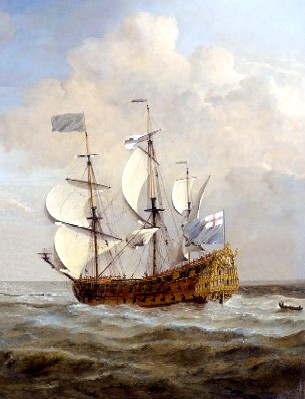
Artist: Willem van de Velde the Younger
First Rate HMS St. Andrew at Sea (c. 1673)
From the beginning, alcohol and its component parts traveled. In his mid-17th century book Familiar Letters, James Howel explained, "“From Bachrag [Bacharach, Germany] the first stock of Vines, which grow now in the grand Canary Island, were brought, which with the heat of the Sun and the Soil, is grown now to that height of perfection, that the Wine which they afford are accounted the richest, the most firm, the best bodied and lastingest Wine"1. As noted, wine grapes were similarly transported by the Portuguese to Madeira and by the Spanish to vineyard-friendly South American countries such as Chile and Argentina so that wine could be produced there rather than having to rely on imports. In the same way, sugar cane was planted on Caribbean Islands such as Jamaica, Barbados and Martinique, which eventually provided the raw materials for rum. Sugar cane wasn't originally planted with an eye towards making rum, but once the process had been discovered, it became a major facet of sugar-growing plantations in the West Indies.
Many of the islands off of Portugal and Northwestern Africa provided stopping points for ships bound to the East and West Indies. Charles Grey explains, "Ships on the outward voyage would call at the Canaries, the Cape Verdes, St. Helena, Table Bay (then called Saldanha) and after rounding the Cape, at some place on the Madagascar coast, or the Islands."2 Thomas Porter noted that La Palma in the Canary Islands was "well stored with Cattle, Cheese, Sugar, and Wine; and is the place where our Ships touch to Refresh themselves, in their Voyage towards America."3
While the Cape of Good Hope had a winery established in 1685, the remote Atlantic island of St. Helena did not. Francis Rogers says "[t]he principle liquor here [James Valley at St. Helena] is Arrack punch"4,
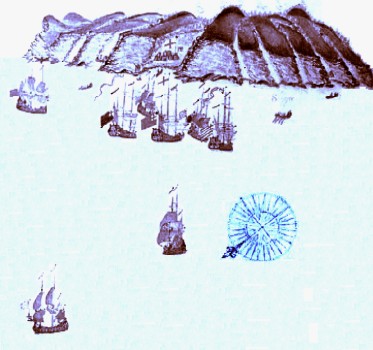
Artist: Edward Barlow
"The Maner of the West side of the Iland of Sint Helena" (1671)
although he does not explain whether it was made there or imported. Dampier also mentions punch houses on the island, something the sailors would have delighted in. Sailors travelling in the East Indies had access to arrack, while those in the Mediterranean could buy wine and brandy in a variety of French and Spanish ports. "The intrinsic quality of wine was less important than how easily it could be shipped to Britain and the rest of the world. This is why so many traditional wine regions are on the coast or on easily navigable rivers with access to the lucrative British markets."5
However, the real story of alcohol traveling, at least for this discussion, has to do with its transport from one place to another on ships. "In early modern Europe, seamen considered alcohol a necessary provision on trading ventures. Although wine and brandy filled the hulls of ships departing Europe, Caribbean sugar planters exploited the maritime demand for alcohol on the other side of the Atlantic and sold rum to traders for the return voyage."6
It has already been noted that alcohol was an important part of the well-known triangle trade - rum and brandy both served as a form of currency for purchasing slaves. "African chiefs and traders valued the novelty of the beverage, and it became a central item in gift-giving ceremonies and a secondary item of trade."7 Slaver Thomas Phillips said that in 1693 and 94 small cowry shells and brass basins were "[t]he best goods to purchase slaves" at Whydaw, Africa, but other goods such cloth, beads and brandy were also used.8
Although the slave-rum/sugar-European goods triangle is probably the most widely discussed trade route involving England and the West Indies, it was only one of several. Henry Jeffreys discusses another one.

Some of the Other 'Triangle' Trade Routes in the Caribbean
The English ...had something the Portuguese wanted- cod. Salt cod or bacalhau is, with pork, the most important ingredient in Portuguese cooking. There was a triangular trade between Britain, Newfoundland and Portugal (seen in orange at right). English woolens would go to Newfoundland to be exchanged for cod, which would be taken to Portugal in exchange for wine.9
Rum helped create a third 'triangle' of trade (seen in green at right - it's actually more of a rectangle because of stops in places like the Canaries on the way down Europe and Africa to catch the trade winds across to the West Indies). In this trade triangle, sugar plantations in the British Caribbean islands of Barbados and Jamaica sent sugar and rum to the Colonies, who loaded the ships with tobacco. This, along with some of the sugar and rum, was sent back to England, with the ships then returning to the West-Indies with desired English goods. "British officials embraced British Caribbean rum as an ally in their war against foreign spirits that had drained England of capital for centuries. They opened the home market to British Caribbean rum and offered incentives to rum makers, including low import duties. In 1719, British imports of rum surpassed those of brandy for the first time."10
Rum was actually quite the windfall product for the Caribbean. "The early rum trade catered to markets at the margins of the emerging Atlantic world. British and French Caribbean planters exported rum to non-sugarcane growing regions of the Spanish Americas and sold it to Carib Indians in the Lesser Antilles."11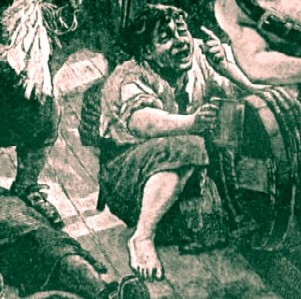
Artist: Edward Barlow
"The Maner of the West side of the Iland of Sint Helena" (1671)
Because they had greater natural resources available to them, the Colonies would send things that were scarce in the Caribbean, such as grain and lumber, back to Barbados and Jamaica on ships returning to the Caribbean.12 Alcohol itself was imported to the Caribbean to satisfy the varied tastes of the plantation owners and other locals. Writing in 1696, John Ovington estimated that eight to nine thousand pipes of wine were exported yearly from the island of Madeira, "most of it to the West Indies, especially to Barbadoes, where it is drunk more liberally than other European Wines."13
The letters of merchant and shipowner William Bolton, who lived on Madeira from 1695 to 1714 , repeatedly mention ships bringing goods desired on the island such as cloth, food and furniture and trading or selling it so that they could take wine and 'succatts' (oranges) from the island to other places, particularly the West and East Indies.14
Bolton's summary of wine shipments from Madeira on December 7, 1697 provides an interesting overview of Madeiran wine moving around the world during this period:
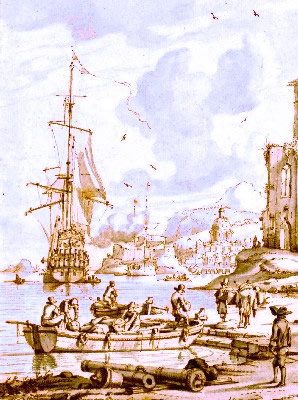
Artist: Abraham Storck
Port Ships and Characters in Port (1674)
The Shrewsbury Gally is sailed for Jamaica. A ship of New England bound with 150 Pipes for Barbados and where [ever else it] can find a Markett.
A ship of Bristol, 60 Pipes for Jamaica;
A ship with 60 Pipes for Boston;
A Brigantine, of Bermudas, 150 Pipes for Curisao and Jamaica;
A Sloope, from Nevis; about 45 Pipes, returned [to Nevis];
A Brigantine, 60 Pipes for Antigua;
A Pink, 100 Pipes for Jamaica;
A Briganteen, 70 Pipes for Boston;
All these are sailed in Seventeen dayes past...15
The majority of the wines shipped from Madeira headed for the West Indies, with Barbados and Jamaica receiving the vast majority, although wines were sent to several other Caribbean Islands including those mentioned above along with St. Kitts16, St. Thomas17 and Monserrat18. Bolton's letters also mention wines being shipped to a variety of other places including New York19, Boston20, Philadelphia21, Virginia22, (North) Carolina23, Maryland24, New London, Connecticut25, Flushing (Vlissingen, Norway)26, Guinea (West Africa)27, India28, Batavia29, Brazil30, and Ireland31, among other places. There is an interesting aside to this data; a marked increase in shipping of Madeira wines to the Colonies began around 1708. Bolton'a company also shipped some wine back to England, typically white wines32 along with small quantities of the much sought after Malmseys33. Few malmseys were bottled, so they were primarily sent to the company's business partners and family of the employees.
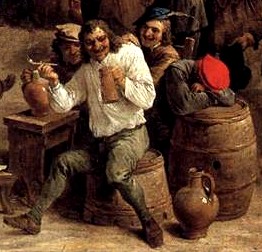
Artist: David Teniers the Younger (1650)
Alcohol could also be used to turn a quick profit for a ship if the situation was right. Thomas Phillips ran into an interloper [a ship not legally authorized to trade in a place] who was coming from Barbadoes with a cargo of rum. Since Phillips was with the Royal African Company, he had authorization to trade. "I bought about 500 gallons of him cheap, and sold it to good advantage"34.
Not all exported liquor made it to the intended destination, of course. Some of it evaporated during shipment, which was referred to as the 'angel's share', as mentioned previously. Some of it was robbed from the cargo by the crew. Jovial French priest Jean Baptiste Labat noted that the sailors' drinking exploits came "at the expense of the cargo. After tapping a cask they would fill it up again with sea-water and thus ruin the wine that was left in it. The unfortunate people who have ordered the wine have no redress for this pillage and destruction which they have very frequently to endure."35
Of course, some of it was pirated. When pirates took a vessel with alcohol on board, they typically loaded that cargo onto their vessel. As briefly discussed in the sections on arrack and punch, pirates sometimes took small amounts of alcohol which were probably meant to
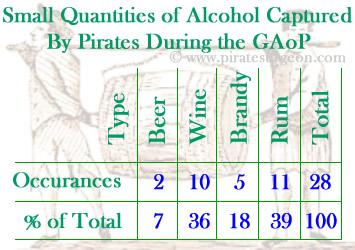
Small Quantities of Alcohol Captured By Pirates During the GAoP
be drank back on their ship. Twenty-one such accounts are included in this study36 and they include twenty-eight instances of alcohols being plundered by the pirates. The breakdown in percentages can be seen in the chart at left.
Several of these accounts specifically mention the pirates taking sugar along with the alcohol, suggesting that their intent was to make punch from the ingredients. In six of the eleven instances where rum was taken from a ship by pirates, they also took sugar37. One one of the accounts mentions both brandy and wine being taken with sugar suggesting the lot would eventually be made into punch.38 If punch was included in this chart where punch ingredients were taken with the alcohol, the total occurrences of piracy of small quantities of alcohol would be reduced to twenty-seven and the percentages would shift accordingly. Beer would stay the same (7%), wine would be reduced from ten to nine (33%), brandy from five to four (15%), rum from eleven to five (19%) and there would be seven occurrences of punch (26%). However, since it cannot be verified that the alcohols taken in these citations were actually drank as punch, the data in the chart must be said to be the more accurate.
The pirates also took large cargos of alcohol which were likely more than they would have drank, although this possibility cannot be ruled out given how large some of the pirate crews were. Still, the reason the merchant ships they took had large quantities of alcohol on board was that it was valuable to those on land and while pirates enjoyed
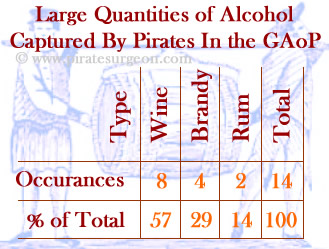
Large Quantities of Alcohol Captured By Pirates During the GAoP
alcohol, they were also interested in making money. There are twelve instances of pirates taking large cargos which include fourteen different alcohols.39 The chart at right shows the instances of each alcohol and its percentage of the total.
This data does not include any beer, probably because beer found on a merchant ship was likely meant for the crew, not for commercial use, so there wouldn't be much of it. Beer had a tendency to go bad at sea and was usually gone before a ship reached the Caribbean or East-Indies. (Of course, like any rule of thumb, this is not always true. There is at least one period example of bottled beer being sent as cargo to India as mentioned.) There are only two instances of rum in this data and one of them can only be inferred. Pirate captain Thomas White's crew captured a French ship which was "laden with liquors from Martinico [Martinique]"40. Since Martinique was one of the French Caribbean islands which manufactured rum, it is likely (although not certain) that the cargo would have been rum.
Most of the texts used here do not give specific quantities of the alcohols captured by the pirates, stating something like a ship was "loaden with wine"41. However quantities are mentioned a few times. The Boston Gazette reported in 1724 that pirate Don Benito captured 1000 Gallons of Rum42 John Sparks testified that Henry Every nabbed 800 cases of Brandy43 and Johnson mentioned that Edward Low 's crew stole 300 gallons of brandy.44 Although pirates are credited with being large consumers of alcohol, such quantities seem excessive even for them.
1 James Howel, Epistolæ Ho-Elianæ, 1726, p. 366; 2 Charles Grey, Pirates of the Eastern Seas (1618-1723), 1933, p. 50; 3 Thomas Porter, A Compleat Delineation and Description of Several Regions & Countries in the Whole World, 1661, p. 75-6; 4 Francis Rogers. from Bruce S. Ingram's book Three Sea Journals of Stuart Times, 1936, p. 192; 5 Henry Jeffreys, Empire of Booze, 2016, p. 5; 6 Jack S. Blocker, Jr., David M. Fahey, and Ian R. Tyrrel, eds., “Rum”, Alcohol and Temperance in Modern History, 2003, p. 525; 7 Blocker, Fahey, and Tyrrel, p. 526; 8 Thomas Phillips, 'A Journal of a Voyage Made in the Hannibal', A Collection of Voyages and Travels, Vol. VI, Awnsham Churchill. ed., p. 190; 9 Jeffreys, p. 30; 10 Blocker, Fahey, and Tyrrel, p. 526; 11 Blocker, Fahey, and Tyrrel, p. 526; 12 Blocker, Fahey, and Tyrrel, p. 526;13 John Ovington, A Voyage to Suratt in 1689, 1696, p. 9-10; 14 See William Bolton, The Bolton Letters, vol. 1, 1928; 15 Bolton, Vol. 1, p. 91; 16 Bolton, The Bolton Letters, Vol. 2, 1960, p. 53, 69, 83,84; 17 Bolton, Vol. 2, p. 82; 18 Bolton, Vol. 2, p. 23, 41, 44, 73, 76; 19 Bolton, Vol. 1, p. 51 & Bolton, Vol. 2, p. 62, 68, 72, 75, 79, 83 & 84; 20 Bolton, Vol. 2, p. 62, 71, 79, 81 & 83; 21 Bolton, Vol. 2, p. 44, 75, 80, 83 & 85; 22 Bolton, Vol. 2, p. 53 & 72; 23 Bolton, Vol. 1, p. 51; 24 Bolton, Vol. 2, p. 62, 68, 71, 75, 76, 82, 83 & 85; 25 Bolton, Vol. 2, p. 79; 26 Bolton, Vol. 2, p. 81; 27 Bolton, Vol. 1, p. 108; 28 Bolton, Vol. 1, p. 117 & 132 & Bolton, Vol. 2, p. 59 & 83; 29 Bolton, Vol. 2, p. 61; 30 Bolton, Vol. 1, p. 127 & Bolton, Vol. 2, p. 43, 54, 62, 63 & 73; 31 Bolton, Vol. 1, p. 156 & Bolton, Vol. 2, p. 67 & 78; 32 Bolton, Vol. 2, p. 60, 64, 70 & 76; 33 Bolton, Vol. 2, p. 48, 49, 52, 53, 64, 72, 76 & 83; 34 Phillips, p. 190; 35 Pere Jean-Baptiste Labat, The Memoirs of Pére Labat 1693-1705, 1970, p. 146; 36 Daniel Defoe (Captain Charles Johnson), A General History of the Pyrates, Manuel Schonhorn, ed., 1999, p. 71 & 314, Ed Fox, “21. The Whydah survivors tell their stories”, Pirates in Their Own Words, 2014, p. 86, Fox, “30. Alexander Thompson: The Information of Alexander Thompson, 2 March 1722.", Pirates in Their Own Words, p. 141 & 142, Fox, “32. Thomas Lawrence Jones: The Examination of Thomas Lawrence Jones, 13 February 1724. HCA 1/55, ff. 50-52”, Pirates in Their Own Words, p. 159, Fox, “33. James Williams, from The Examination of James Williams, 27 March, 1725. HCA 1/55 ff. 103-104”, Pirates in Their Own Words, p. 161, Fox, “43. Henry Treehill, from The Information of Henry Treehill, 21 March, 1724. HCA 1/55, ff. 64-68”, Pirates in Their Own Words, p. 202, 203, 205 & 206, Fox, “61. Bridstock Weaver and William Ingram, The Proceedings on the King's Commission of Oyer and Terminer... (London, 1725)", Pirates in Their Own Words, p. 321-2, "119. Trial of John Fillmore and Edward Cheesman. May 12, 1724”, Privateering and Piracy in the Colonial Period Illustrative Documents, John Franklin Jameson, 1923, p. 281, “120. Trial of William Phillips and Others. May 12, 1724”, Privateering and Piracy in the Colonial Period Illustrative Documents, Jameson, p. 277 & 281, The Arraignment, Tryal, and Condemnation of Capt. John Quelch”, 1704, p. 11, The Boston Gazette, 4/27-5/4/1724, The Boston News-Letter, Monday, August 4. To Monday August 11. 1718, The Boston News-Letter, Thursday April 30. To Thursday May 7. 1724, The Trial of Eight Persons Indited for Piracy &c, 1718, p. 9, The Tryals of Major Stede Bonnet, 1719, p. 49; 37 Defoe (Captain Charles Johnson), p. 314, Fox, “21. The Whydah survivors tell their stories”, p. 86, Fox, “43. Henry Treehill, from The Information of Henry Treehill, 21 March, 1724. HCA 1/55, ff. 64-68”, p. 202 & 203, Fox, “61. Bridstock Weaver and William Ingram, The Proceedings on the King's Commission of Oyer and Terminer... (London, 1725)",p. 321-2, The Tryals of Major Stede Bonnet, p. 49; 38 The Boston Gazette, 4/27-5/4/1724; 39 Defoe (Captain Charles Johnson), p. 303, 325, 361-2, 474, 581, 583 & 589, Fox, “3. John Sparks. The Examination of John Sparks, 10 September, 1696. HCA 1/53, f. 18”, p. 35, Fox, “7. James Kelly on two decades at sea. (London, 1700)”, p. 48, Fox, “33. James Williams, from The Examination of James Williams, 27 March, 1725. HCA 1/55 ff. 103-104”,p. 162, Fox, “34. John Smith, alias John Gow, from The Examination of John Smith, 2 April, 1725. HCA 1/55 ff. 105-106”, p. 166, The Boston Gazette, Monday July 6. To Monday July 13, 1724; 40 Defoe (Captain Charles Johnson), p. 474; 41 For examples, see Defoe (Captain Charles Johnson), p. 162, 361, 474, 581, 583 & 589; 42 The Boston Gazette, Monday July 6. To Monday July 13, 1724; 43 Fox, “3. John Sparks. The Examination of John Sparks, 10 September, 1696. HCA 1/53, f. 18”, p. 35; 44 Defoe (Captain Charles Johnson), p. 325
Booze and Business: Paving the Way
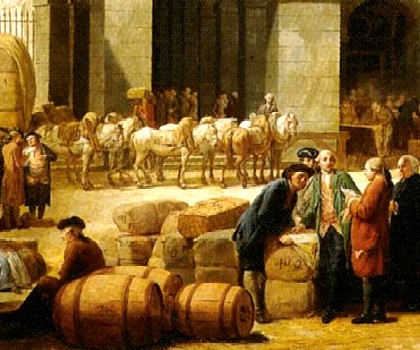
Artist: Nicolas Bernard Lépicié
Conducting Business, From The Courtyard of the Customs House (1775)
Alcohol itself was an important part of business at sea: socializing, networking and just generally schmoozing officials, business partners, clients and anyone else involved in facilitating business transactions was expected. Booze served as an important social lubricant, helping make sales and trade go a little easier. (Which basically means that things really have not changed very much.)
As Captain Thomas Phillips of the Royal African Company's slave ship Hannibal so aptly put it, "We are always very kind to good traders [at Cape Corse in what is now Ghana], giving them store of good punch and brandy"1.
Alcohol was used to entertain various local government officials and monarchs. When slaver William Snelgrave was in Jaqueen (Jakim, modern Godomy in Benin, Africa), the king of Dahomé (or Dahomey, also in Benin), Buttenoe, asked to see him. Snelgrave was uneasy about the meeting, but the King's messenger told him, "That if I did not go, it would highly offend the King; that he feared I should not be permitted to trade, besides other bad Consequences might follow."2 So he went to meet the king, who "drank to us in Palm Wine... which is very common in that Country. We returned the Compliment, drinking the King's health both in Wine and Beer we had brought with us, which he seemed to be well pleased with"3.
Thomas Phillips similarly went to meet the queen at Winneba, Africa (modern Ghana) in 1694, where he "presented her with an anchor of brandy each, and some hands of tobacco, which she receiv’d with abundance of thanks and satisfaction"4. While at Whydah (Ouidah in modern Benin, Africa), Phillips was daily "invited to breakfast with the king, where we always found the same dish of stew’d fowls and
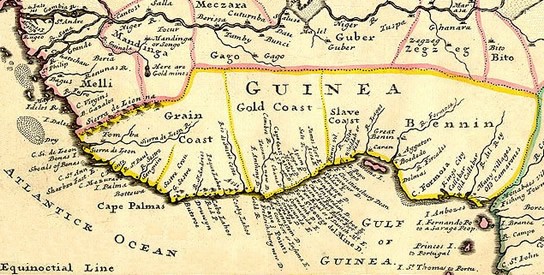
Map maker: Herman Moll - European Settlements on The Guinea Coast (1736)
potatoes; he also would send us a hog, goat, sheep, or pot of pitto [fermented corn alcohol] every day for our table, and we usually return’d his civility with three or four bottles of brandy, which is his summum bonum [ultimate goal]"5.
Perhaps the most interesting account of Phillips sharing a beverage with a local monarch comes from time he spent at Cape Mesurado (near modern Monrovia, Liberia). While meeting with King Andreo, another unnamed King from further inland approached them. Although King Andreo ignored the new guest, Phillips invited the man in. "I could not perswade him to come up to us, therefore I had a bowl of punch brought where he was, of which he drank very freely, till he saw the bottom; I would have had another made for him, but could not persuade he presented me with a good leopard’s skin, worth 3 or 4 l. [pounds] in England, and I him with 3 or 4 bottles of rum, and as many handfuls of cowries [shells], and so we parted very friendly"6.
African Kings weren't the only local officials who rated attention from traders. In Jakim, Snelgrave befriended an African colonel who took him and his men to his tent "where we were treated with Palm Wine, we returned to our own, being accompanied by him, and we desired him to stay to Supper."7
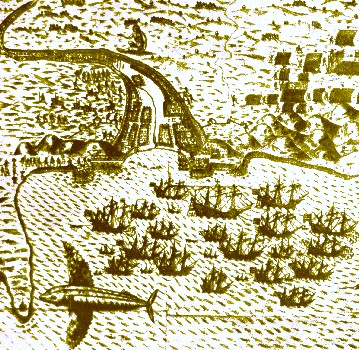
Artist: Theodore de Bry -
Santiago, Cape Verde Islands (1589)
While at Santiago in the Cape Verde Islands, Phillips met with the governor there where they shared "a loaf of good white bread; then he [the governor of Santiago,] went into the next room and brought out a box of marmalad, and a square case bottle half full of Madeira wine in which he drank to me"8. The governor then did his best to help Phillips obtain provisions.
Alcoholic beverages were also valuable tools for helping to establish and maintain business relationships. At Whydah, Phillips explained that in arranging to buy slaves he would take the local King's "cappasheir [caboceer – African appointed to supply Europeans with slaves] ...to my warehouse, where, after I had well warm’d him with brandy and other strong liquors (the key of most secrets) express’d abundance of kindness to him, and made him some presents, I have desir’d him to be very ingenuous [open and honest] and free with me"9. He further noted that the caboceers "would drink out of any cup, or any liquor we would give them; and we seldom fail’d of their custom three or four times a day, when they must each have a large glass of brandy, which they drank as freely as we do claret. When we went to the trunk we were oblig’d always to carry three or four bottles of brandy to drink at our bargains"10.
Africa is not the only place where alcohol was used to jolly the local business people. When sailor Edward Barlow was serving on the merchant ship fflorentine in 1675, he reported that the ship's master had a feast on board the ship. To this he invited "some of the merchants of the town [of Bergen, Norway] on board, they had a very good dinner, and drinking several healths, they were very merry and drunk so long that they were almost fuddled [stupefied by drink]"11. The next day, their ship was loaded with fish for transport.
Sometimes the merchant vessels used alcohol to help calm a prospective seller down. After Captain Phillips left
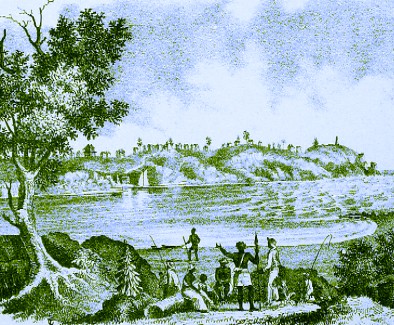
Cape Palmas in What is Today Ghana, Africa (1853)
Cape Palmas and was near Cabala-ho (probably Cabo Lahoe, what is today called Grand Lahoe in Côte d'Ivoire, Africa) some men came near the ship with "store of good teeth" (ivory), but were very cagy about trading with him. First, "they requir'd that the captain of the ship should come down the out side of the ship, and drop three drops of the sea water into his eye, as a pledge of friendship, and of safety for them to come aboard", which Phillips did.12 They then came aboard, but were frightened by the sight of so many men on the ship and left again. (It sounds as if they may have encountered pirates in the past, who were heavily manned and who would likely have just taken their ivory once they were on the ship.) Phillips tried to get them to return, but to no avail. He persevered, explaining, "I was much concern’d at their fearfulness, and with much perswasion prevail’d on them to return, which they did; and having given each that came in a good coge of brandy, I shew'd them some of my commodities, and they brought in [aboard] some teeth"13.
When Phillips was at Axim in Ghana, Africa, he invited the factor [commissioned agent] of the Dutch factory [business center or warehouse] Mr. Rawlisson to come aboard where the man ate, drank and then amused
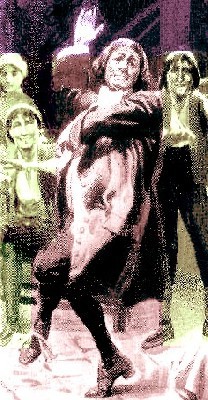
A Pastoral Dance, from A Set of
Rogues, by Frank Barrett, p. 355 (1895)
himself by "singing and dancing by himself several jiggs", until a large canoe approached Phillips' ship. The factor "immediately leap'd into a small canoe that was selling fish by the ship's side ...and squatting himself down in her flat upon his belly, made the canoe men row away to the west with all the force they could"14. Phillips suggests that Rawlisson was afraid the canoe contained Dutch factory inspectors who searched their factories to check if there were "any goods or merchandize in them besides what belongs to the company, which the factors or governors often clandestinely buy of interlopers and English ships"15. Fortunately alcohol and dancing enticed him to return. "Rawlisson, some time after he got ashore, sent out a canoe a scouting, by which understanding his mistake, he banish’d his fear, and resolv’d to have t’other jigg with us; and accordingly we soon had him aboard, where he continu’d till late at night, and was carry’d ashore well ballasted with wine and punch"16.
Phillips also used alcohol to encourage workers when purchasing certain goods. He explained that good water and firewood could be gotten from Cape Baxos, by the Sestos (Cestos) River in what is now Liberia, Africa. He says that the African women would bring wood and water to a ship for the price of some hatchets, cowry shells, "but they must have a bottle of brandy now and then among them to encourage them: so that for expedition this is the best place along the whole coast to wood and water at."17
Alcohol was also sometimes used to complete a deal and keep the sellers happy. Woodes Rogers reported that King of Bouton (Pulau Buton in Indonesia) brought rice when arrangements were being made to supply the Duke and Dutchess ships with provisions, "which (for Dispatch-sake) we immediately agreed for, and a Cask of Rack [arrack], and after we had entertain'd 'em as well as Time and Place would afford, we sent 'em off in our Pinnace."18
1 Thomas Phillips, 'A Journal of a Voyage Made in the Hannibal', A Collection of Voyages and Travels, Vol. VI, Awnsham Churchill. ed., p. 206; 2 Captain William Snelgrave, A New Account of Some Parts of Guinea and the Slave Trade, 1734, p. 23; 3 Snelgrave, p. 28; 4 Phillips, p. 210; 5 Phillips, p. 218; 6 Phillips, p. 193; 7 Snelgrave, p. 50; 8 Phillips, p. 186; 9 Phillips, p. 220; 10 Phillips, p. 221; 11 Edward Barlow, Barlow’s Journal of his Life at Sea in King’s Ships, East and West Indiamen & Other Merchantman From 1659 to 1703, p. 256; 12,13 Phillips, p. 197; 14,15 Phillips, p. 200; 16 Phillips, p. 200; 17 Phillips, p. 195; 18 Woodes Rogers, A Cruising Voyage Round the World, 1712, p. 385
Booze and Business: The Pirate 'Trade'
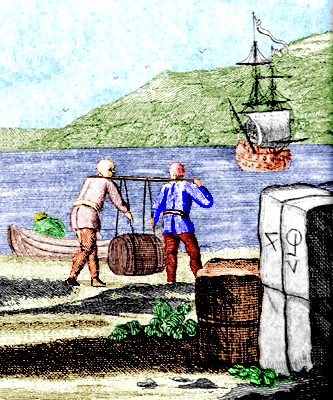
Artist: Joseph Nicholls
Loading Blackbeard's Ship With Supplies (1736)
"After Supper, a Bowl of Punch, and half a
Dozen [bottles] of Claret, being set on the Table, Capt.
Russel [of Edward Low's companion schooner] took a Bumper, and drank Success to their
Undertaking; which went round [the room]... Next Health was Prosperity to Trade,
meaning their own Trade." (George Roberts, The four years voyages of capt. George Roberts, 1726, p. 72)
Although it may seem counter intuitive to talk about the business of piracy, there was a business model underlying successful pirates during this period. Part of their success certainly relied on luck in finding targets that had goods and money on board. To facilitate their 'trade', however, pirates also needed the same sort of supplies which any ship needed to complete its journey and mission. This included food, water, wood for fires when they were lit, gunpowder, ammunition, items required to maintain and repair the ship, surgical supplies needed to maintain and repair the men and so forth. Such things were all important, but they were incidental to a successful pirate ship's most important resource: her crew.
Men were obviously needed to direct and man the ship, make decisions, cook, perform surgery and maintenance and other, similar day-to-day tasks. However, men were a part of the greatest advantage a pirate ship had over a merchant vessel: fear. A pirate ship could instill fear through their reputation, their flags, superior weaponry and the number of men they had aboard. The pirates' target, merchant ships, were minimally manned and a show of force went a long way to convincing a prey ship to give up without a fight. (It wasn't usually their ship, so it was easier to surrender to a superior foe.) As a result, successful pirates usually had a fairly large crew and that crew needed to be kept happy, a key component of which was clearly alcohol.
Drinking seems to have been a popular sport with pirates as several accounts indicate. Captain Charles Johnson noted that Bartholomew Roberts had difficulty keeping his crew under control because they were "almost always mad or drunk"1. At the trial of Bartholomew Roberts' men, James Munjoy testified that when pirate
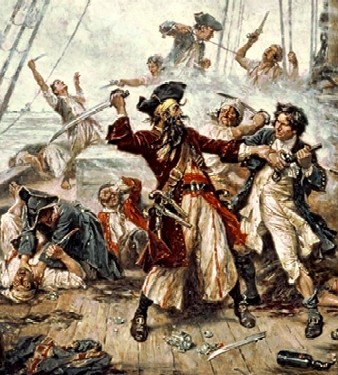
Artist: Jean Leon Gerome Ferris
The 'Business' of Piracy, "Capture of the Pirate Blackbeard" (1920)
James Cromby came aboard the captured ship Elizabeth, he "fell to drinking and swearing, the Vices he saw they were all enamour'd of."2 Merchant captain Nathaniel Uring noted that the logwood cutters, "are generally a rude drunken Crew, some of which have been Pirates, and most of them Sailors; their chief Delight is in drinking"3. Of course, there is the wonderful citation found in Johnson, supposedly taken from Blackbeard's Journal as cited previously, which noted that things went badly when the crew ran out of rum, so he took a prize ship "with a great deal of Liquor on board, so kept the Company hot, damn’d hot, then all Things went well again."4 (This is widely believed to be apocryphal since there is no other record of Blackbeard having a journal.) There are a variety of other citations which bear out the ever-present need for alcohol on most pirate ships to keep the business going, but the point is fairly made.
Most pirate ships seem to have had problems with turnover shipboard; there's something about the threat of a violent death if you were caught by the officials that makes it difficult for some men to want to stay with the job. In addition, many pirate ships had large numbers of 'pressed' or forced men who didn't want to be aboard a pirate ship at all and took the first opportunity they had to escape. If those things weren't enough of a problem for maintaining head count, men occasionally died by accident, at the hands of a fellow crew member or in battle. As a result, a pirate ship constantly needed to recruit new crew members. Alcohol was one way to encourage men to join.
Upon spotting a small boat beaching on the shore near Ocho Rios Bay, Jamaica, Pirate John Rackham's crew called to them saying, "they were English Men and desired the Pettiauga's [periauger's] Men to come on Board, and drink a Bowl of Punch, which they were prevailed upon to do,
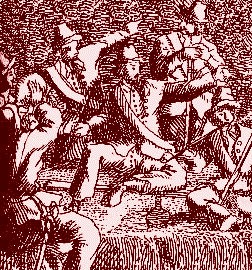
Edward Low's Men Drinking, From Histoire der
Engelsche Zee-Roovers (1725)
accordingly the Company came all aboard of the Pyrate, consisting of nine Persons, in an ill Hour; they were armed with Muskets and Cutlashes"5. No sooner were the men aboard than Captain Jonathan Barnet appeared and the men were found themselves aboard a pirate ship being chased by the men who would eventually catch Rackam.
There are a variety of examples of alcohol being mentioned as a recruitment tool. During the trial of Bartholomew Roberts' men, Stephen Thomas Testified that John Jessup "presently got drunk with the Pyrates, and so continued always, saying, and swearing, it was better living among Pyrates, than at Cabo Corso Castle."6 When testified to the reason he joined the pirates at the trial, Robert Armstrong said that "it was Drink, and over perswasion of the rest engaged him to it."7 Harry Glasby similarly testified that Joseph Mansfield "was always drunk and asleep, and aforetime to have been too guilty of that Vice, which had a great Share in drawing him into such Company."8 Upon being convicted of piracy with Captain John Phillips' crew, William White said in his dying declaration, "Drunkenness has had a great Hand in bringing my Ruin upon me. I was drunk when I was enticed aboard the Pyrate."9
1 Daniel Defoe (Captain Charles Johnson), A General History of the Pyrates, Manuel Schonhorn, ed., 1999, p. 224; 2 "Pyrates Lately taken by Captain OGLE", 1723, p. 41; 3 Nathaniel Uring, A history of the voyages and travels of Capt. Nathaniel Uring, 1928, p. 241; 4 Defoe (Captain Charles Johnson), p. 86; 5 Defoe (Captain Charles Johnson), p. 152; 6 "Captain OGLE", p. 73; 7 "Captain OGLE", p. 76; 8 "Captain OGLE", p. 51; 9 Defoe (Captain Charles Johnson), p. 351

